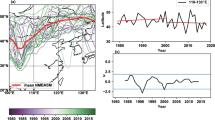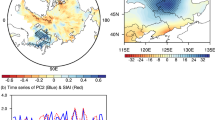Abstract
Located in the Yangtze River Valley and surrounded by mountains, South-Central China (SCC) frequently suffered from natural disasters such as torrential precipitation, landslide and debris flow. Here we provide corroborative evidence for a link between the late spring (May) snow water equivalent (SWE) over Siberia and the summer (July–August, abbr. JA) rainfall in SCC. We show that, in May, anomalously low SWE over Siberia is robustly related to a large warming from the surface to the mid-troposphere, and to a stationary Rossby wave train from Siberia eastward toward the North Atlantic. On the one hand, over the North Atlantic there exhibits a tripole pattern response of sea surface temperature anomalies in May. It persists to some extent in JA and in turn triggers a wave train propagating downstream across Eurasia and along the Asian jet, as the so-called Silk Road pattern (SRP). On the other hand, over northern Siberia the drier soil occurs in JA, accompanied by an overlying anomalous anticyclone through the positive feedback. This anomalous anticyclone favors the tropospheric cooling over southern Siberia, and the meridional (northward) displacement of the Asian jet (JMD) due to the change in the meridional temperature gradient. The combination of the SRP and the JMD facilitates less water vapor transport from the tropical oceans and anomalous descending motion over SCC, and thus suppresses the precipitation. These findings indicate that May Siberian SWE can be exploited for seasonal predictability of SCC precipitation.










Similar content being viewed by others
References
Balsamo G et al (2015) ERA-interim/land: a global land surface reanalysis data set. Hydrol Earth Syst Sci 19:389–407
Bamzai A, Marx L (2000) COLA AGCM simulation of the effect of anomalous spring snow over Eurasia on the Indian summer monsoon. Q J R Meteorol Soc 126:2575–2584
Bamzai AS, Shukla J (1999) Relation between Eurasian snow cover, snow depth, and the Indian summer monsoon: an observational study. J Clim 12:3117–3132
Barnett TP, Dümenil L, Schlese U, Roeckner E, Latif M (1989) The effect of Eurasian snow cover on regional and global climate variations. J Atmos Sci 46:661–686
Chen G, Huang R (2012) Excitation mechanisms of the teleconnection patterns affecting the July precipitation in Northwest China. J Clim 25:7834–7851
Cohen J, Rind D (1991) The effect of snow cover on the climate. J Clim 4:689–706
Cohen J, Barlow M, Kushner PJ, Saito K (2007) Stratosphere–troposphere coupling and links with Eurasian land surface variability. J Clim 20:5335–5343
Dash S, Singh G, Shekhar M, Vernekar A (2005) Response of the Indian summer monsoon circulation and rainfall to seasonal snow depth anomaly over Eurasia. Clim Dyn 24:1–10
Dash S, Parth Sarthi P, Panda S (2006) A study on the effect of Eurasian snow on the summer monsoon circulation and rainfall using a spectral GCM. Int J Climatol J R Meteorol Soc 26:1017–1025
Dee DP et al (2011) The ERA-interim reanalysis: configuration and performance of the data assimilation system. Q J R Meteorol Soc 137:553–597
Dickson RR (1984) Eurasian snow cover versus Indian monsoon rainfall—an extension of the Hahn–Shukla results. J Clim Appl Meteorol 23:171–173
Duan H, Wang S, Feng J (2013) The national drought situation and its impacts and causes in the summer 2013. J Arid Meteorol 31:633–640
Fan K, Wang H, Choi Y (2008) A physically-based statistical forecast model for the middle-lower reaches of the Yangtze River Valley summer rainfall. Chin Sci Bull 53:602–609
Fasullo J (2004) A stratified diagnosis of the Indian monsoon—Eurasian snow cover relationship. J Clim 17:1110–1122
Fischer EM, Seneviratne SI, Vidale PL, Lüthi D, Schär C (2007) Soil moisture–atmosphere interactions during the 2003 European summer heat wave. J Clim 20:5081–5099
Fletcher CG, Hardiman SC, Kushner PJ, Cohen J (2009) The dynamical response to snow cover perturbations in a large ensemble of atmospheric GCM integrations. J Clim 22:1208–1222
Groisman PY, Karl TR, Knight RW (1994) Observed impact of snow cover on the heat balance and the rise of continental spring temperatures. Science 263:198–200
Gu W, Li C, Wang X, Zhou W, Li W (2009) Linkage between mei-yu precipitation and North Atlantic SST on the decadal timescale. Adv Atmos Sci 26:101–108
Hahn DG, Shukla J (1976) An apparent relationship between Eurasian snow cover and Indian monsoon rainfall. J Atmos Sci 33:2461–2462
Halder S, Dirmeyer PA (2017) Relation of Eurasian snow cover and Indian summer monsoon rainfall: importance of the delayed hydrological effect. J Clim 30:1273–1289
Henderson GR, Peings Y, Furtado JC, Kushner PJ (2018) Snow–atmosphere coupling in the Northern Hemisphere. Nat Clim Change 8:954–963
Hong X, Lu R (2016) The meridional displacement of the summer Asian Jet, Silk Road pattern, and tropical SST anomalies. J Clim 29:3753–3766
Huang R, Chen W, Yang B, Zhang R (2004) Recent advances in studies of the interaction between the East Asian winter and summer monsoons and ENSO cycle. Adv Atmos Sci 21:407–424
Lin Z, Lu R (2005) Interannual meridional displacement of the East Asian upper-tropospheric jet stream in summer. Adv Atmos Sci 22:199
Linderholm HW et al (2011) Interannual teleconnections between the summer North Atlantic Oscillation and the East Asian summer monsoon. J Geophys Res Atmos 116:D13107
Liu Y, Fan K (2014) An application of hybrid downscaling model to forecast summer precipitation at stations in China. Atmos Res 143:17–30
Lu R-Y, Oh J-H, Kim B-J (2002) A teleconnection pattern in upper-level meridional wind over the North African and Eurasian continent in summer. Tellus A Dyn Meteorol Oceanogr 54:44–55
Meng L, Long D, Quiring SM, Shen Y (2014) Statistical analysis of the relationship between spring soil moisture and summer precipitation in East China. Int J Climatol 34:1511–1523
Orsolini YJ, Zhang L, Peters DH, Fraedrich K, Zhu X, Schneidereit A, van den Hurk B (2015) Extreme precipitation events over north China in August 2010 and their link to eastward-propagating wave-trains across Eurasia: observations and monthly forecasting. Q J R Meteorol Soc 141:3097–3105
Rayner N et al (2003) Global analyses of sea surface temperature, sea ice, and night marine air temperature since the late nineteenth century. J Geophys Res 108:1063–1082
Robock A, Mu M, Vinnikov K, Robinson D (2003) Land surface conditions over Eurasia and Indian summer monsoon rainfall. J Geophys Res Atmos 108:4131
Rossby T (1996) The North Atlantic current and surrounding waters: at the crossroads. Rev Geophys 34:463–481
Sardeshmukh PD, Hoskins BJ (1988) The generation of global rotational flow by steady idealized tropical divergence. J Atmos Sci 45:1228–1251
Shen H, He S, Wang H (2019) Effect of summer Arctic sea ice on the reverse August precipitation anomaly in Eastern China between 1998 and 2016. J Clim 32:3389–3407
Sun B (2017) Seasonal evolution of the dominant modes of the Eurasian snowpack and atmospheric circulation from autumn to the subsequent spring and the associated surface heat budget. Atmos Ocean Sci Lett 10:191–197
Sung MK, Kwon WT, Baek HJ, Boo KO, Lim GH, Kug JS (2006) A possible impact of the North Atlantic Oscillation on the east Asian summer monsoon precipitation. Geophys Res Lett 33:L21713
Takala M et al (2011) Estimating northern hemisphere snow water equivalent for climate research through assimilation of space-borne radiometer data and ground-based measurements. Remote Sens Environ 115:3517–3529
Takaya K, Nakamura H (2001) A formulation of a phase-independent wave-activity flux for stationary and migratory quasigeostrophic eddies on a zonally varying basic flow. J Atmos Sci 58:608–627
Tian B, Fan K (2012) Relationship between the late spring NAO and summer extreme precipitation frequency in the middle and lower reaches of the Yangtze River. Atmos Ocean Sci Lett 5:455–460
Walsh JE, Jasperson WH, Ross B (1985) Influences of snow cover and soil moisture on monthly air temperature. Mon Weather Rev 113:756–768
Wang H (2002) The instability of the East Asian summer monsoon–ENSO relations. Adv Atmos Sci 19:1–11
Wang B, Wu R, Fu X (2000) Pacific–East Asian teleconnection: how does ENSO affect East Asian climate? J Clim 13:1517–1536
Wang B, Liu J, Yang J, Zhou T, Wu Z (2009) Distinct principal modes of early and late summer rainfall anomalies in East Asia. J Clim 22:3864–3875
Wegmann M, Orsolini Y, Dutra E, Bulygina O, Sterin A, Brönnimann S (2017) Eurasian snow depth in long-term climate reanalyses. The Cryosphere 11:923–935
Wu B, Yang K, Zhang R (2009) Eurasian snow cover variability and its association with summer rainfall in China. Adv Atmos Sci 26:31–44
Xie P, Arkin PA (1997) Global precipitation: a 17-year monthly analysis based on gauge observations, satellite estimates, and numerical model outputs. Bull Am Meteorol Soc 78:2539–2558
Xie S-P, Hu K, Hafner J, Tokinaga H, Du Y, Huang G, Sampe T (2009) Indian ocean capacitor effect on Indo–Western Pacific climate during the summer following El Niño. J Clim 22:730–747
Xu L, Dirmeyer P (2011) Snow-atmosphere coupling strength in a global atmospheric model. Geophys Res Lett. https://doi.org/10.1029/2011GL048049
Xu L, Dirmeyer P (2013) Snow–atmosphere coupling strength. Part II: albedo effect versus hydrological effect. J Hydrometeorol 14:404–418
Xu B, Chen H, Sun S, Gao C (2018) Large discrepancy between measured and remotely sensed snow water equivalent in the northern Europe and western Siberia during boreal winter. Theor Appl Climatol 137:133–140
Yang J, Liu Q, Xie SP, Liu Z, Wu L (2007) Impact of the Indian Ocean SST basin mode on the Asian summer monsoon. Geophys Res Lett 34:L02708
Yasunari T, Kitoh A, Tokioka T (1991) Local and remote responses to excessive snow mass over Eurasia appearing in the northern spring and summer climate. J Meteorol Soc Jpn Ser II 69:473–487
Yim S-Y, Jhun J-G, Lu R, Wang B (2010) Two distinct patterns of spring Eurasian snow cover anomaly and their impacts on the East Asian summer monsoon. J Geophys Res 115:D22113
Zhang R, Zuo Z (2011) Impact of spring soil moisture on surface energy balance and summer monsoon circulation over East Asia and precipitation in East China. J Clim 24:3309–3322
Zhang YL, Li BY, Zheng D (2002) A discussion on the boundary and area of the Tibetan Plateau in China (Chinese). Geogr Res 21:1–8
Zhang R, Zhang R, Zuo Z (2017) Impact of Eurasian spring snow decrement on East Asian summer precipitation. J Clim 30:3421–3437
Zuo Z, Yang S, Zhang R, Xiao D, Guo D, Ma L (2015) Response of summer rainfall over China to spring snow anomalies over Siberia in the NCEP CFSv2 reforecast. Q J R Meteorol Soc 141:939–944
Acknowledgements
This study was supported by the National Key R&D Program of China (Grant No. 2016YFA0600703), the National Natural Science Foundation of China (Grant Nos. 41421004, 41605059, 41875118, and 41505073). Fei Li acknowledges support from the RCN Nansen Legacy Project (Grant 276730) and the Bjerknes Climate Prediction Unit with funding from the Trond Mohn Foundation (Grant BFS2018TMT01). Yvan J. Orsolini acknowledges support from the Research Council of Norway (Grant No. SNOWGLACE #244166).
Author information
Authors and Affiliations
Corresponding author
Additional information
Publisher's Note
Springer Nature remains neutral with regard to jurisdictional claims in published maps and institutional affiliations.
Electronic supplementary material
Below is the link to the electronic supplementary material.
Rights and permissions
About this article
Cite this article
Shen, H., Li, F., He, S. et al. Impact of late spring Siberian snow on summer rainfall in South-Central China. Clim Dyn 54, 3803–3818 (2020). https://doi.org/10.1007/s00382-020-05206-5
Received:
Accepted:
Published:
Issue Date:
DOI: https://doi.org/10.1007/s00382-020-05206-5




